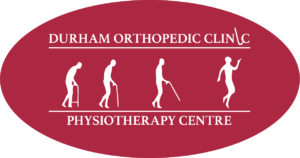A pulled groin, also known as a groin strain is a common injury, especially among athletes who play sports like soccer, hockey, or tennis. It occurs when the inner thigh muscles (called adductors) are overstretched or torn. While painful and inconvenient, a pulled groin can heal well with the right physiotherapy plan.
If you’re dealing with groin pain, our team at Durham Orthopedic & Sports Injury Clinic is here to help.
What Are the Signs of a Pulled Groin?
- Sharp pain in the inner thigh
- Swelling or bruising
- Difficulty walking or changing directions quickly
- Weakness in the leg
Early treatment is essential to avoid long-term complications and re-injury.
Phase 1: Immediate Care (0–3 Days After Injury)
In the first 72 hours after a groin strain, the goal is to reduce inflammation and pain.
- Rest: Avoid sports or movements that make it worse.
- Ice: Apply cold packs for 15–20 minutes, 3–5 times per day.
- Compression: Consider a groin wrap for support.
- Elevation: If possible, keep the leg elevated to reduce swelling.
- Important: Don’t stretch the muscle during this stage. It could worsen the tear.
Phase 2: Gentle Movement & Pain-Free Strength (Days 4–10)
After the initial inflammation has reduced, physiotherapy focuses on gentle activation of the groin muscles.
- Isometric Exercises: Lying down and gently pressing your knees together.
- Mobility Work: Pain-free leg slides and basic movements to restore motion.
- Modalities: Laser therapy or ultrasound may be used to promote healing.
Phase 3: Strength & Stability (Weeks 2–3)
Once pain is under control, it’s time to rebuild strength and prevent future injuries.
- Resistance Exercises: Bands and bodyweight movements to strengthen the inner thigh.
- Core Strengthening: Planks, bridges, and pelvic control work to support the hip and groin.
- Gentle Stretching: Adductor and hip flexor stretches, guided by a physiotherapist.
Phase 4: Functional & Sport-Specific Training (Weeks 3–6+)
As healing progresses, we’ll get you back to full strength with dynamic training.
- Lateral Lunges & Step-Ups: Great for regaining control and mobility.
- Agility Drills: Side shuffles, ladder work, and directional changes (introduced gradually).
- Sport Re-integration: Tailored to your sport, under professional supervision.
When to See a Physiotherapist
You should consult a physiotherapist if:
- Pain lasts more than 7–10 days
- You’re limping or can’t bear weight
- You’re an athlete and want a safe return to sport
At Durham Orthopedic & Sports Injury Clinic, we treat sports injuries like groin strains with personalized rehab programs. Whether you’re an athlete or just want to move pain-free again, our team is here to support your recovery from start to finish. Contact us today to book your appointment!


